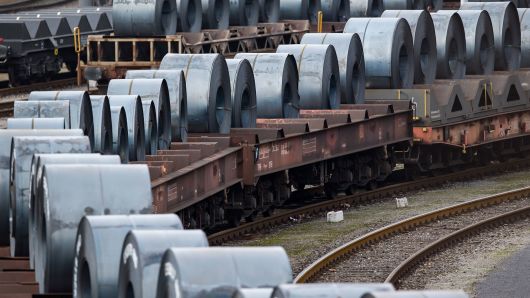
Germany’s Thyssenkrupp and India’s Tata Steel signed a final agreement on Saturday to establish a long-expected steel joint venture, the European steel industry’s biggest shake-up in more than a decade.
The final agreement comes after months of negotiations since an initial agreement was announced in September. Both companies hope it will help them respond to challenges in the volatile steel industry, including overcapacity.
The largest deal in Europe’s steel industry since the takeover of Arcelor by Mittal in 2006, the 50-50 joint venture – to be named Thyssenkrupp Tata Steel – will have about 48,000 workers and about 17 billion euros ($19.9 billion) in sales.
Based in the Netherlands, it will be the continent’s second-largest steelmaker after ArcelorMittal. It forms the core of Thyssenkrupp CEO Heinrich Hiesinger’s plan to turn his steel-to-submarines conglomerate into a technology company.
“The joint venture not only addresses the challenges of the European steel industry,” Hiesinger said. “It is the only solution to create significant additional value of around 5 billion euros for both Thyssenkrupp and Tata Steel due to joint synergies which cannot be realized in a stand-alone scenario.”
Tata Steel Chairman Natarajan Chandrasekaran, in a separate statement, said the joint venture will create “a strong pan- European steel company that is structurally robust and competitive”.
The deal comes as European steel makers face tariffs of 25 percent on their exports to the United States, their biggest market. That might force local market to absorb more volume as a result.
Since the tariffs were announced in late May, shares in European steelmakers ArcelorMittal, Thyssenkrupp, Salzgitter and Voestalpine have lost 8 to 17 percent.
Fresh terms
Hiesinger had faced pressure from activist shareholders Cevian and Elliott to extract more commitments from Tata Steel, whose European business has performed worse than Thyssen’s since the agreement was first announced, creating a valuation gap.
Thyssenkrupp said the deal included “proper compensation” for the gap, which it said was in the mid-triple-digit million- euro range: if the joint venture makes a widely expected initial public offering it would get a bigger share of the proceeds.
Thyssenkrupp said it also secured the right to decide when a listing might take place, adding the joint venture was aiming for a dividend payout in the low-to-mid-triple-digit million- euro range.
The German group also said it now expects annual synergies of 400 million to 500 million euros from the transaction. It said additional synergies were possible through managing capital expenditure and optimising working capital.
Tata Steel will remain liable for environmental risks in Britain, where its Port Talbot factory, the least profitable of the joint venture, is based, said Markus Grolms, vice chairman of Thyssenkrupp’s supervisory board.
He also said that Tata Steel’s Dutch unit would be part of the joint venture’s cash-pooling mechanism. That had been a key demand for German workers concerned that Tata would give its own workers better conditions in the new company.
“Yes, we do want to protect people. But we also want a company with better chances and less risks,” Grolms said.
Thyssenkrupp’s management will present a refined strategy to its supervisory board in the second week of July. Sources said that may include a sale of its Materials Services unit and further cost cuts.
